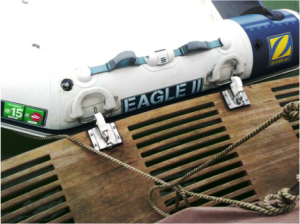Forespar's Point of View
Blogging About Life on the WaterMonthly Archives: January 2016
Pole Storage
Forespar offers a variety of options to storing your whisker pole or spinnaker pole. The traditional method of storage is to keep your pole on the deck using deck chocks. This storage method is highly recommended for sailing in heavy weather. The chocks are made from Marelon, making them durable and rugged, and use a “snag-proof” low profile design. These chocks are secured to the deck, usually near the bow and next to or clamped to a lifeline stanchion. This keeps the pole secured and out of the way, and at the same time easily accessible.
POV – Mike Dwight
WINTERIZED?
WINTERIZED
Well of course you are. Even SoCal boaters should winterize some systems by sealing and waterproofing and covering against the rainy season.
But if you live in the rest of the world, where there actually is winter, and temperatures fall below freezing, there are a couple of hints, one large and one small:
First, Marelon® plumbing systems from Forespar© don’t require winterizing like bronze does. Marelon won’t freeze and crack. The small amount of water trapped in the ball valves won’t expand enough to cause damage, as the dynamic seals can hold up to the small expansion. So, while you’re in there in the spring, if you find a suspect valve and/or pipe section, replace it with Marelon. For operation and winterizing purposes, it’s much better than our old school bronze.
Second, if you’re using anti-freeze for any purposes try not to use ethylene glycol-based anti-freeze. It is not environmentally or human health friendly. Try to find virgin propylene glycol blend product (there are a couple of major brands) made for marine purposes. They will give you excellent cold weather and corrosion protection for your drinking water systems and engines, without the potentially toxic side effects. And with an additive, the propylene glycol version will prevent corrosion of aluminum and copper pipe, brass and solder, and will not harm rubber and other seals, or hoses.
It is usually fashionably pink – giving excellent blow-through visibility. And, it will not harm the water strainers and lids from Forespar and other manufacturers.
Hope this helps a little in waters where snow and ice are the norm. Both are still good ideas for year-round boaters too.
POV – Mike Dwight
What Good is a Dinghy Davit on My Swimstep?
The obvious benefit is the ability to hoist your inflatable dinghy up on the swimstep while it’s inflated. That way, you’re not fighting to unroll, inflate and float the dinghy using the limited deck space on a small to medium sized boat, and then reverse the process. Often, that means you’re spending as much time setting up the supposedly convenient dinghy as you did on the voyage.
Plan B is to tow the dinghy. For a longer trip, especially at sea, this can be an adventure of its own. Speed, tow distance from the boat, cleats (often not designed for those loads) and tow lines and yokes can be a real pain. We haven’t even mentioned the motor, gas can and cargo.
With the swimstep davit system, you can simply bring the dinghy alongside, clip it on and tilt/hoist it in. A side and actually major benefit is overnight stays. By clipping the dinghy into the Davit, we can be sure that it sits quiet in the water. There’s no banging on the hull, drifting into the fairway, worrying about the painter, etc. Easy passenger boarding from the swimstep, and easy back onto the boat.

We’re using the Forespar QuikDavit ™version on two boats. One on the Grand Banks, used for hoisting and parking the smaller dinghy, and with the mounting pads the same distance apart for docking the bigger Caribe.
The Wellcraft uses the full QuikDavit kit as designed. It is easy for Pat (the real Skipper) to use, and was easy to install on both the wood step and the thicker step on the smaller boat. It makes for a much more pleasant cruise, and has proven to be well worth the money.
POV – Mike Dwight –
Respected Sailing World Spokesperson John Kretschmer Comments on Forespar’s Whisker Poles
“My Forespar 50/50 Whisker Pole is a workhorse, no other piece of equipment on Quetzal is more useful for efficient off the wind sailing. I would not go to sea without it.”